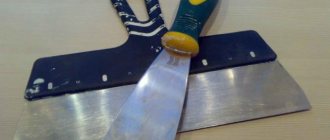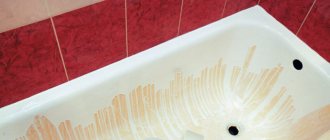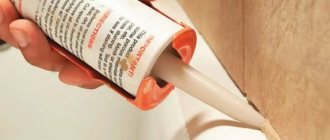You can repair a damaged surface at home. Depending on the nature of the defect, the following materials can be used for sealing:
Acrylic and enamel bathtubs are vulnerable to mechanical stress. In areas of damage, rust, mold and colonies of pathogenic bacteria form, so the integrity of the coating must be restored as quickly as possible. Liquid acrylic, porcelain white, enamel aerosol, fiberglass patches, etc. are used to repair chips on the bathtub.
- 1 Reasons for chipping
- 2 Types of damage to bathtub coatings
- 3 Materials needed
- 4 Surface preparation
- 5 Ways to repair a chip in the bathroom 5.1 Porcelain chips
- 5.2 Dry white
- 5.3 Spot enameling
But first, you need to understand what types of problems exist and only then think about how to remove a chip on the bathtub, repair a gap or hole, and in general, what you need to have on hand “just in case.”
How to patch a hole in an acrylic bathtub?
A crack appeared in the bathtub.
Water does not drip, but flows. Is there anything I can do or throw away? The option for sealing a crack is as follows: identify the size of the crack (with an alcohol-based paint (ink); drill the ends of the cracks with a drill with a diameter of 1 mm (so that the crack does not spread); degrease the crack and the area near it with 646 solvent or acetone; seal the crack using geos77 or cold welding. If the repair option is on the side surface, then it will work, if the crack is on the bottom, then the bath will be thrown into the scraps or you will have to make a hatch from the outside in order to treat the crack on both sides.
It all depends on the diameter (size) of that hole.
Small through holes can be sealed with liquid acrylic and a hardener.
Sold as a set (set), that is, you need a repair kit for acrylic bathtubs.
You can buy it separately; liquid acrylic requires fine-grained sandpaper, as well as a solvent.
The surface near the hole is cleaned and degreased.
If the hole or crack is too large, then liquid acrylic alone will not help.
The hole must be reinforced (from the back of the bath).
To do this, you need fiberglass and epoxy resin with a hardener.
In principle, instead of fiberglass, you can use a bandage and gauze.
At least three layers.
After this “patch” has completely dried, seal the hole on the outside with liquid acrylic.
And before gluing the “patch” and under the liquid acrylic, the surfaces are degreased, that is, a solvent is needed in any case.
If the aesthetic component is not important, the main thing is reliable sealing, then you can buy these flat-head screws.
The screws have nuts, washers and rubber gaskets.
There is a washer under the screw head, then a rubber gasket.
They inserted the same “pie” into the hole and from the back side, but with a nut.
Border tape - the final touch
- a practical option for finishing a silicone seam or processing a joint after polyurethane foam;
- does not require additional processing;
- high moisture resistance;
- fragility.
This solution will allow you to quickly and beautifully seal the gap, achieving a magnificent visual effect. Use only after you have already treated the joint with silicone or polyurethane foam. Please note the correct sequence:
- Apply any assembly adhesive from the “liquid nails” series over the seam;
- attach border tape to the wall and along the edge of the bathtub;
- carefully treat the joints and corners with silicone sealant.
The latter method requires more than a day to dry, but the result is a beautiful, modern option that will definitely please any housewife.
Advice:
The width of the tape should be at least 2 times the width of the gap between the bathtub and the wall.
How to repair chipped enamel in a bathroom
The bathroom, like other household items, requires proper care. If it is absent or carried out incorrectly, the appearance of the bathroom may become worse. In addition, careless handling can lead to various types of damage.
In order not to buy a new bathtub, for which you often do not have enough financial resources or time, you can repair the resulting flaws yourself. Repairing chipped enamel bathtubs is a fairly simple procedure that anyone can do.
Types of possible damage
Depending on the type of bathtub and its material, damage may also vary. The most common are acrylic, cast iron and steel bathtubs. They may all have similar damage that you can fix yourself.
Glass, wooden and marble bathtubs cannot be repaired: such models are considered exclusive, and without the help of a specialist, everything can only get worse.
The most common possible damages are:
- chipping is a fairly common type of damage. It is better to seal it immediately and not wait for it to increase;
- scratches – this problem is most serious for acrylic bathtubs, since deep scratches can lead to the bathtub splitting;
- splitting – applies only to acrylic bathtubs and may be the result of a deep scratch or a bathtub that is too thin;
- rust - can be present in almost any bathtub;
- a hole is a defect that is the most labor-intensive to repair. Only a specialist or a special insert can help here.
Damage Prevention
In order to avoid various types of defects, it is necessary to follow all instructions for bathtubs. Taking into account all the requirements of the product, you can keep its appearance perfect for many years.
Basic rules for proper use of bathtubs from professionals:
- do not place metal or other objects that can damage the enamel in the bathtub or on its edges;
- the cleaning agent must be soft, it must not contain any kind of abrasives, and the use of chlorine bleaches is also unacceptable;
- If possible, protect the bath from sharp objects;
- during repair work, the bathtub should be covered with a thick film;
- Do not use for cleaning or pour substances containing acid onto the product;
- the bathroom itself must have fairly thick walls;
- You can't jump in the bathroom, even for a child.
A little about damage prevention
Of course, knowing how to repair enamel or deal with rust, you can be somewhat careless when it comes to covering a bowl. But is it worth it to repair chipped bathtubs every year if it’s enough to simply prevent this? So, advice from experienced people:
- choose a mild bath cleaner without abrasives of any fraction;
- do not allow the bowl to come into contact with hard materials (basins, hammer);
- do not pour acid or acid-containing preparations into the font;
- do not scratch the bowl with sharp objects (at the time of repair, it is better to cover the bathtub with a soft cloth or bubble wrap);
- do not use chlorine or other bleaches;
- do not jump in the bathtub (even a baby can damage the bottom of an acrylic bathtub);
- choose a product with walls that have an acceptable thickness threshold.
This last point especially applies to acrylic bowls. The fact is that many manufacturers allow thinning of the walls, casting fonts of exquisite shapes. Therefore, it is extremely important to choose a bowl “for light”. If you turn the font opposite a bright light source, it should be uniformly smooth, without any translucent areas. This means that the manufacturer did not skimp on the material and in the near future you will not be in danger of restoring the coating or restoring a chip on the wall or bottom of the bathtub.
Chip on the bathtub
Such damage occurs very often precisely because of non-compliance with the operating requirements of the product. A chip that appears is very often left unattended, which is wrong. Some people think it’s very difficult to do this, others think it’s not worth it. As a result, the chip becomes larger and more and more noticeable.
Indeed, if you repair the chip yourself, you still won’t be able to restore the original appearance of the product. Bathtubs are made at very high temperatures, and it is not possible to create the same surface at home. And if this procedure is carried out incorrectly, then very soon the patch will begin to rust or even fall off. That is why it is important to repair chipped bathtub enamel with your own hands correctly, taking into account all the details. The process itself does not take much time and requires only accuracy and the desire to get a good result.
Preparation for repair
Preparation is a very important stage that should not be missed. The quality of the repair and its service life will depend on its implementation. As mentioned earlier, the chip needs to be repaired immediately. If this is not done, rust may form and must be removed. If the chip is fresh, then this stage of preparation can be skipped.
- Removing rust. To do this, you will need such improvised means as a knife, needles, and screwdriver. They can be used to remove rust. You can also use a special product to remove it, which is sold in household chemical stores. If it is missing, then a regular cleaning agent will do. After all manipulations, the rust-free chip should be rinsed well with water.
- You can also remove dirt . It must be remembered that such products should not contain abrasives.
- After complete cleaning, the repair area is washed well and thoroughly dried with a hairdryer. The surface should be perfectly clean and dry.
- Degreasing is a necessary procedure, without which the durability of the seal will be significantly reduced. Degreasing is carried out using acetone, then dried again with a hairdryer.
We use polyurethane foam
- a good option for sealing even the widest gap between the bathtub and the wall;
- Only types with increased moisture resistance are suitable;
- strong fixation, mold protection.
Pay attention to the composition of the polyurethane foam before purchasing: it is very good if it is made on the basis of polyurethane. The moisture resistance indicator is also more than important - the durability of the structure you create directly depends on it. The entire procedure is below:
- Clean the work surface well and degrease it;
- protect your hands with gloves;
- Shake the can thoroughly, point it into the slot and start spraying gently;
- try not to shake the balloon too much - the foam that gets into unnecessary places will later have to be torn off with force;
- After the joint is completely sealed, use a knife to trim off all the irregularities to get a perfectly smooth and beautiful joint.
Crack repair
Small cracks
Cracks no more than a millimeter thick can be repaired somewhat easier than wider ones. This is a little easier than fixing a chipped bathtub enamel. All work must be carried out in a ventilated area and using protective equipment, since epoxy putty is hazardous to human health.
- The area around the crack is cleaned with sandpaper.
- Small holes are drilled at both ends of the crack with a drill to prevent it from spreading.
- The repair area is thoroughly washed, degreased and dried.
- Epoxy putty is applied with a spatula to the crack itself and the drilled holes. The mixture is leveled and the excess is removed with a spatula.
- After sitting for 12 hours, you can start sanding. The result should be a smooth surface, which must be free of unevenness.
Deep cracks
Initially, as in the previous case, the surface is cleaned with sandpaper, holes are drilled, and the degreasing and drying procedure is carried out. You can speed it up using a regular hairdryer. Then a piece of construction tape is cut off, slightly larger than the crack. The tape needs to be glued to it and smoothed out well, removing excess air from under it.
How to fix a hole in a bathtub
- How to fix a hole in a bathtub
- How to fill a hole
- How to repair a crack in a sink
- — drill with drill Ø2-3 mm;
- - abrasive wheel;
- — repair kit for cosmetic repairs of acrylic bathtubs;
- — repair kit for major repairs of acrylic bathtubs;
- — sandpaper No. 100, 200, 400;
- — universal putty (epoxy, “pe brulex”, etc.);
- — bath enamel (“stakryl”, “epoxin”, “tikkurila reflex 50”, etc.);
- — reinforcing tape with glass fiber;
- - alcohol.
When renovating any bathtub, follow these principles.
The damage should be cut with as gentle bevels as possible. The number of reinforcing layers applied depends on the size of the damage. For very small holes (up to 5 mm), one reinforcing layer is enough, for large ones - 2-3.
When purchasing a repair kit for major repairs of acrylic bathtubs, familiarize yourself with the package. Perhaps it will include products for cosmetic repairs of bathtubs (polish). In this case, there is no need to buy a repair kit for decorative repairs.
How to fix a hole in a bathtub correctly?
There are several ways to solve this problem.
Method 1
Repairing a hole in the bathtub with your own hands
Although we do not recommend repairing holes in bathtubs with improvised materials, here we will still describe the main stages of the process.
Repairing a Hole in a Steel Bathtub (Quick Guide)
Do not caulk, caulk, or seal a hole in the bathtub with improvised materials that are not intended for repairing holes in the bathtub. In most cases, such “repairs” lead to the hole rotting even more after some time.
Repair work should be carried out in this order:
- It is necessary to completely remove all corrosion from the inside and outside of the bathtub. Use sandpaper for this, preferably P80-P100. After this, degrease the surface and dry thoroughly.
- Glue a piece of tin, slightly larger than the hole, onto the car putty on the outside of the bathtub. Instead of tin and putty, you can use self-adhesive foil. Using automotive putty and a rubber spatula, level the repair area from the inside.
- After this, use fine sandpaper (P150) to polish the cured putty so that the repair area is slightly deepened (up to 1 mm).
- Degrease the area to be repaired and thoroughly remove dust.
- Wrap the faucet in plastic to prevent water from entering the repair area.
- Using a small brush, apply a thin layer of bath enamel so that the repair area is flush with the rest of the bathtub. Shine a flashlight from the side onto the painted surface. If you find specks of dust or lint on your brush, remove them with a sewing needle or toothpick.
In a few words, we told you how to repair a hole in a bathtub. But there are still questions to which it is important to know the answers:
- How to avoid smudges when painting on a vertical bathtub surface?
- How to ensure that the repair area does not differ in color from the rest of the bathtub surface?
- How to completely remove corrosion?
The answers to these questions, as well as a complete, step-by-step guide in Ukrainian and Russian, can be found in the instructions for the repair kit, which can be purchased in our online store shop.x-vanna.com.ua.
Below is a video tutorial on how to repair a hole in a bathtub. In addition, you can get a free consultation by calling us at the numbers listed in our online store.
Repairing Holes in Acrylic Bathtubs and Shower Trays (Quick Guide)
Do not attempt to seal the bathtub with epoxy resin. Do not use liquid acrylic or auto-putty to paint the repair area. Acrylic and auto putty will not last long on an acrylic bathtub. And repairing with epoxy resin will most likely lead to you having to throw out the bathtub altogether.
It will not be possible to carry out a full repair using improvised materials. Therefore, in the instructions for carrying out repair work, we will tell you in a few words about the sequence of work using special repair kits.
Carry out repair work in the following order.
Repair of the reinforcing layer of an acrylic bathtub:
- Use the repair kit to repair the reinforcing layer of an acrylic bathtub.
- The repair area must be cleaned of dust and sanded with sandpaper from the kit.
- Degrease the surface with alcohol.
- Prepare the adhesive according to the instructions for the repair kit.
- Soak the glass mat from the kit with the resulting resin and seal the hole with several layers.
- Once the glue has completely cured, begin repairing the hole from the inside of the tub using a chip and crack repair kit.
The most effective ways to repair acrylic bathtub cracks, holes and delaminations
When using acrylic bathtubs, consumers often encounter various problems.
A carelessly placed metal bucket scratches the coating. The cigarette burns through the acrylic. A heavy object falls on the coating and it bursts or, worse, a through hole or delamination appears.
Of course, this is not pleasant, because the appearance of the plumbing is spoiled. But you can deal with all the above defects with your own hands and completely restore the coating. How to restore the surface in case of cracks, breakdowns and delaminations - read below in our article. As for the fight against scratches and chips a separate material for you .
Surface preparation
First of all, before carrying out any restoration work with an acrylic bathtub, you need to prepare the surface:
- Rinse the hot tub thoroughly with warm water;
- Apply detergent to the surface (you can also use a regular soap solution);
- leave to soak for 20-30 minutes.
- wipe the font with a soft sponge - special attention should be paid to the damaged area, it needs to be cleaned more thoroughly;
- rinse generously with water;
- degrease the damaged area. How to do this, read the special article.
How to repair a crack with your own hands?
What to do if the coating of an acrylic bathtub cracks during use, how to repair the crack? It is important to understand that it needs to be eliminated as quickly as possible to avoid further spread. Indeed, under the influence of constant load and temperature difference, it can grow significantly.
Such repairs can be easily done with your own hands using a special repair kit , according to the instructions presented below.
As a rule, a repair kit contains all the components necessary for restoration; in addition to it, you only need a drill or screwdriver and masking tape .
STEP 1. First you need to drill out the crack along the edges, this will help it not to grow in the future. 5mm diameter works great ) and at high speed make small holes at the very ends of the crack.
It is very important not to drill deeply, you only need to dive 2-3 mm into the surface of the acrylic, this is usually enough.
STEP 2. Next, you can begin to expand the crack. This is necessary to ensure that the repair composition completely fills the damage. Run the same drill along the entire length of the crack, creating a 1-2 mm .
STEP 3. Now you need to cover the area around with molar tape so as not to damage the entire coating, and begin to give it a slight roughness. 1000 - 1200 sandpaper and start “shuffling” the coating in a circular motion. Remove all shavings and thoroughly wipe the surface of the defect with a soap solution.
STEP 4. Mix liquid acrylic and hardener in the proportions recommended by the manufacturer.
We use cement mortar
- cheap universal option;
- needs additional processing for better visual reflection;
- reliable, but not durable fixation.
Probably the first thing that comes to mind when the need arises to seal the gap between the bathtub and the nearest wall. The first option is not always as bad as they say. The use of cement mortar is supported by low price and reliability; against - the need to additionally process the joints for a more or less normal decorative effect. This is what it looks like in a dry algorithm of actions:
- we clean the joint from all unnecessary things: dirt, dust, etc.;
- we treat the desired area on the wall with a primer for better interaction with the cement mortar;
- we prepare the solution itself, make it moderately thick;
- We close the gap with rags pre-soaked in the prepared solution;
- after they have dried, apply the solution directly along the entire length of the crack;
- As a means of camouflage, you can choose fragments of ceramic tiles, mosaics, or simply paint over the seam.
Good advice:
if possible, use the same coating as on the wall to obtain a bright decorative effect. It is especially easy to fulfill this condition if you have facing tiles. Buy a few extra tiles - you'll definitely need them, we assure you! Similar tricks can be done in cases where you used other options for decorating the walls in the bathroom.
Repairing holes using a repair kit at home
How to repair a through hole, because they require much more serious repairs? For such cases, bathtub manufacturers produce special repair kits. Their configuration differs from those discussed above only in that they contain sheets of fiberglass and special glue for them. Let's take a closer look at how to use them.
STEP 1. First, you need to prepare the surface for repair: carefully remove all chips around the damage and splinters from the edges of the hole.
The hole will need access from both sides , so if you can’t get to the defect from the other side, you will have to dismantle the font
STEP 2. Cut the fiberglass into sheets of the desired size. A minimum of 3 sheets is required. It is better if the first sheet extends 3 cm beyond the boundaries of the breakdown, and each subsequent sheet extends 2 cm more than the previous one. For example: if the hole is 2x2 cm , then the first sheet should be 8x8 cm , the second 10x10 and the third 12x12 .
This will ensure better adhesion to the surface of the bathtub.
STEP 3. Now you need to coat the fiberglass sheet well with glue and attach it to the back side of the hole. The same must be repeated for the remaining layers.
Each subsequent layer must be glued after the previous one has completely dried - 2-3 hours .
STEP 4. All that remains is to mix liquid acrylic with hardener according to the manufacturer’s instructions and apply it over the layers of fiberglass from the “finishing” side. It is important to smooth it well with a rubber spatula, covering not only the fiberglass, but also the edges of the hole.
STEP 5. You can start sanding and polishing. How to do this is described in detail in step 5 of the previous chapter.
How can you seal small holes?
If the hole diameter is up to 8 mm, you can safely fill it with acrylic without gluing it with fiberglass. Such damage often occurs when installing the frame on a bathtub, when the guides are screwed in and drilled through the bottom. To eliminate such holes, you can use liquid acrylic from the repair kit by injecting it into the hole using a regular medical syringe. After the polymer has dried, it is necessary to sand and polish the surface (step 5 of the chapter “Eliminating cracks”).
Why do you need joint sealing?
Imagine walking into a bathroom after renovation and meticulously inspecting every inch. What do you think your eyes will fall on first? Of course, on the bathtub itself, recently installed by specialists. And after the snow-white coating, you will be disappointed to discover that the distance from the wall to its edge is ugly empty. This will be your first moment of natural disappointment.
The second will come when you use the bathroom for its intended purpose for the first time. And you will find how water literally strives to seep into the recently discovered joint. The consequences of such a repair gap have not only a cosmetic aspect: water flowing onto the floor can ruin the coating and provoke the appearance of fungus or mold.
You need it?
Gaps most often arise due to the disproportion between the length of the bathtub and the wall part to which it is adjacent. You can provide for such a “jamb” even at the repair stage:
- having purchased a bathtub of the required length;
- installing an additional plasterboard partition.
What to do if the coating has peeled off?
Often, when buying a cheap product, after some time the acrylic delaminates and swells. What can contribute to this:
- Installation errors. The bathtub shakes, the walls are deformed, which leads to peeling of the coating.
- Poor quality material.
In order not to encounter such problems, read our special articles: How to choose a high-quality acrylic bathtub? And how to install it correctly?
What to do if the acrylic is still swollen, how to glue it?
It is necessary to glue it back using a special adhesive for polymer products. If the “bubble” is not cracked, you need to pierce it with a syringe with a thick needle and inject glue into it.
If there is a crack, slightly bend the peeled layer and use a syringe to evenly distribute the composition so that the entire delamination is glued.
Further actions are the same as for restoration of cracks.
There is a more radical and high-quality, but less accurate approach. You need to cut off all the swollen acrylic and instead fill this place with the liquid composition from the repair kit. Performing the same procedures as when eliminating a breakdown ( STEP 5 and STEP 6 of the previous chapter). In this case, the integrity of the coating will definitely be restored, but such a patch will immediately catch the eye. Which method to use is up to you.
Another option is silicone sealant.
- it is necessary to select the optimal sealant in terms of moisture resistance and sensitivity;
- It is best used in conjunction with a plunger gun, which allows you to confidently control the entire process;
- used in cases of a gap of no more than 5 mm.
- degrease the gap between the bathtub and the wall and dry thoroughly;
- cut the tube spout at a certain angle, the sharper the angle, the thicker the layer will be;
- Apply sealant along the entire length of the joint between the bathroom and the wall;
- wet your finger in water diluted with soap and walk along the entire seam, evenly pressing the sealant inward;
- apply another layer and repeat the pressing procedure.
If everything is done correctly, then you will be able to seal the gap in such a way that it will be difficult to even notice what you used.
Bonus. Detailed video instructions











